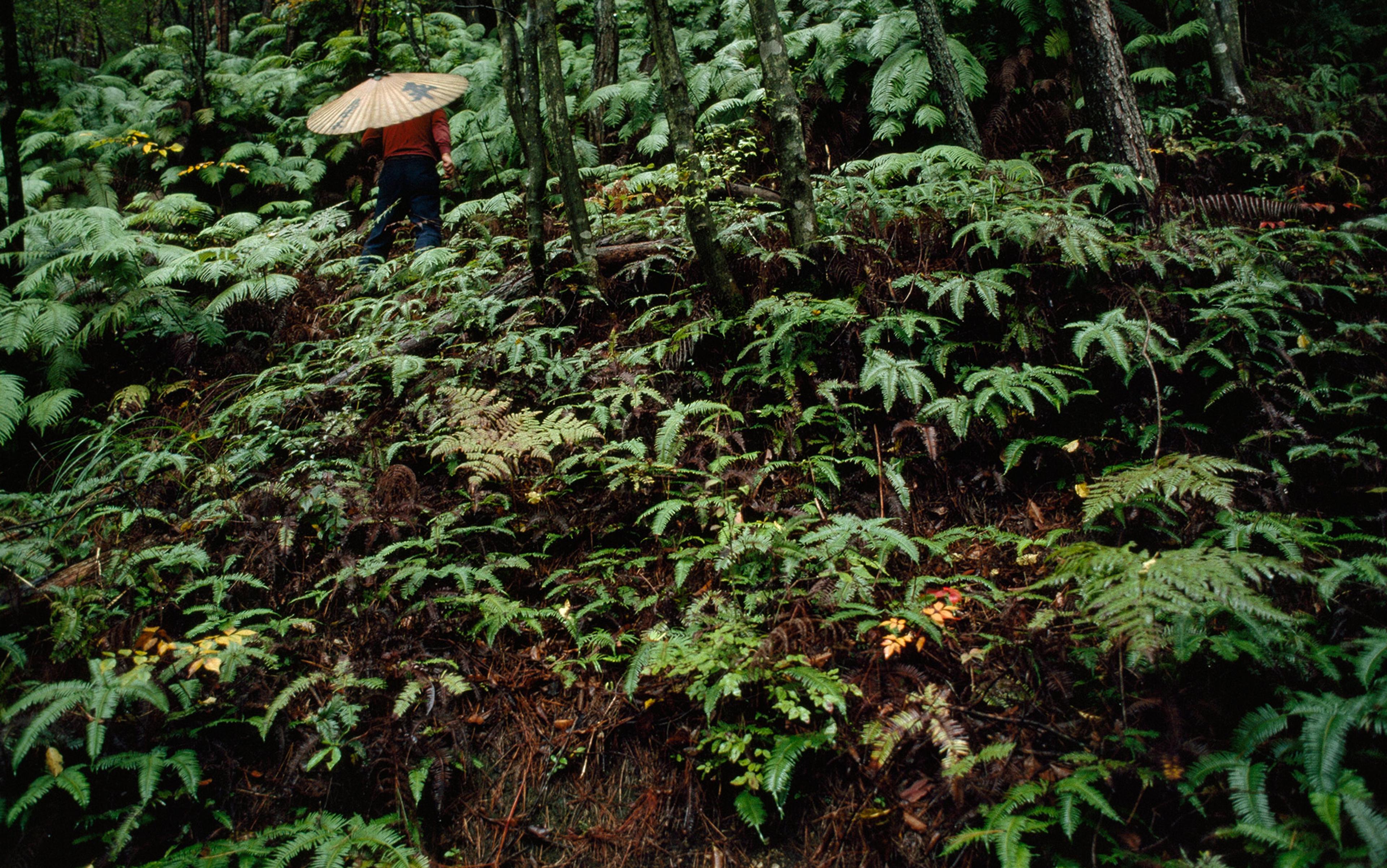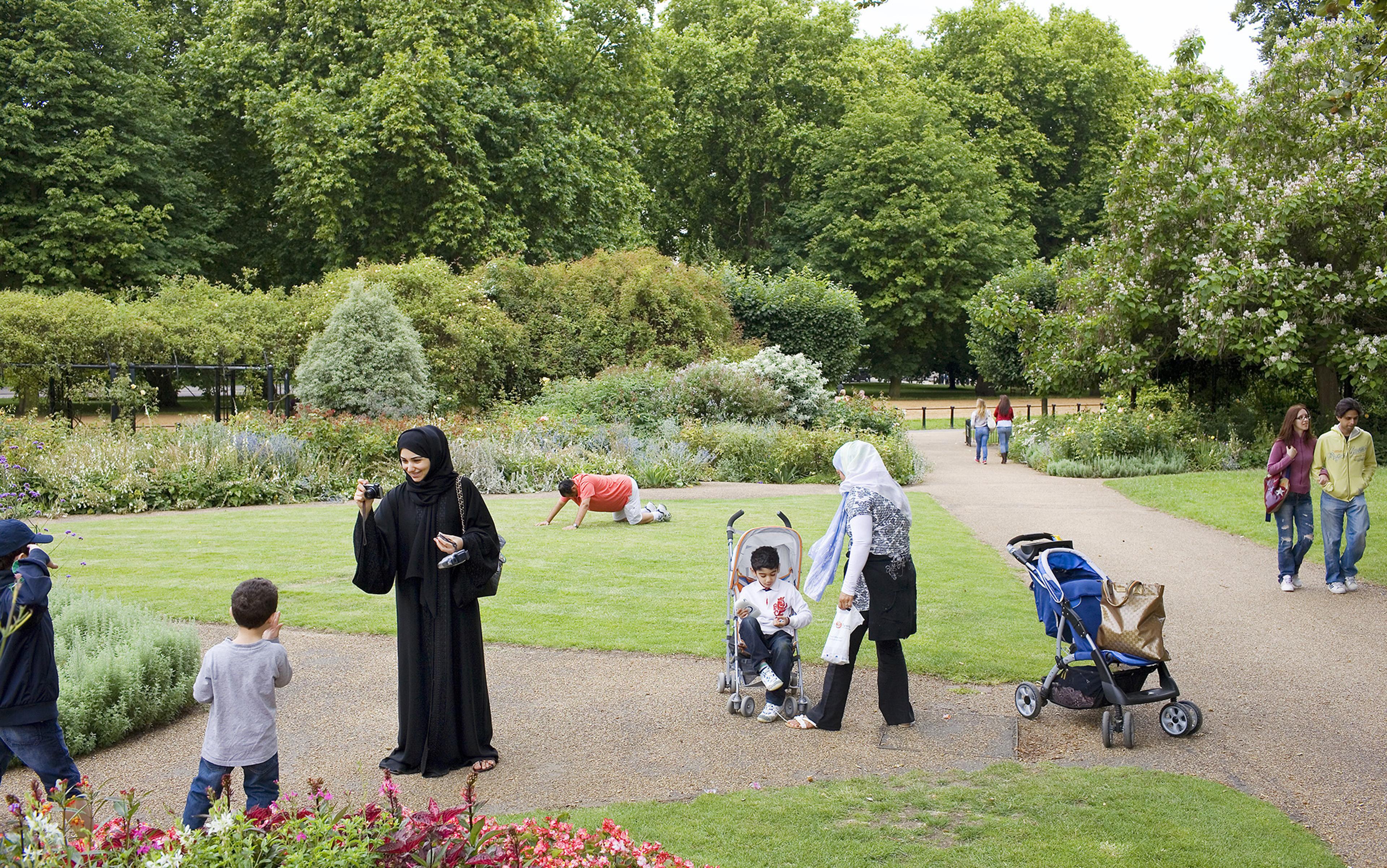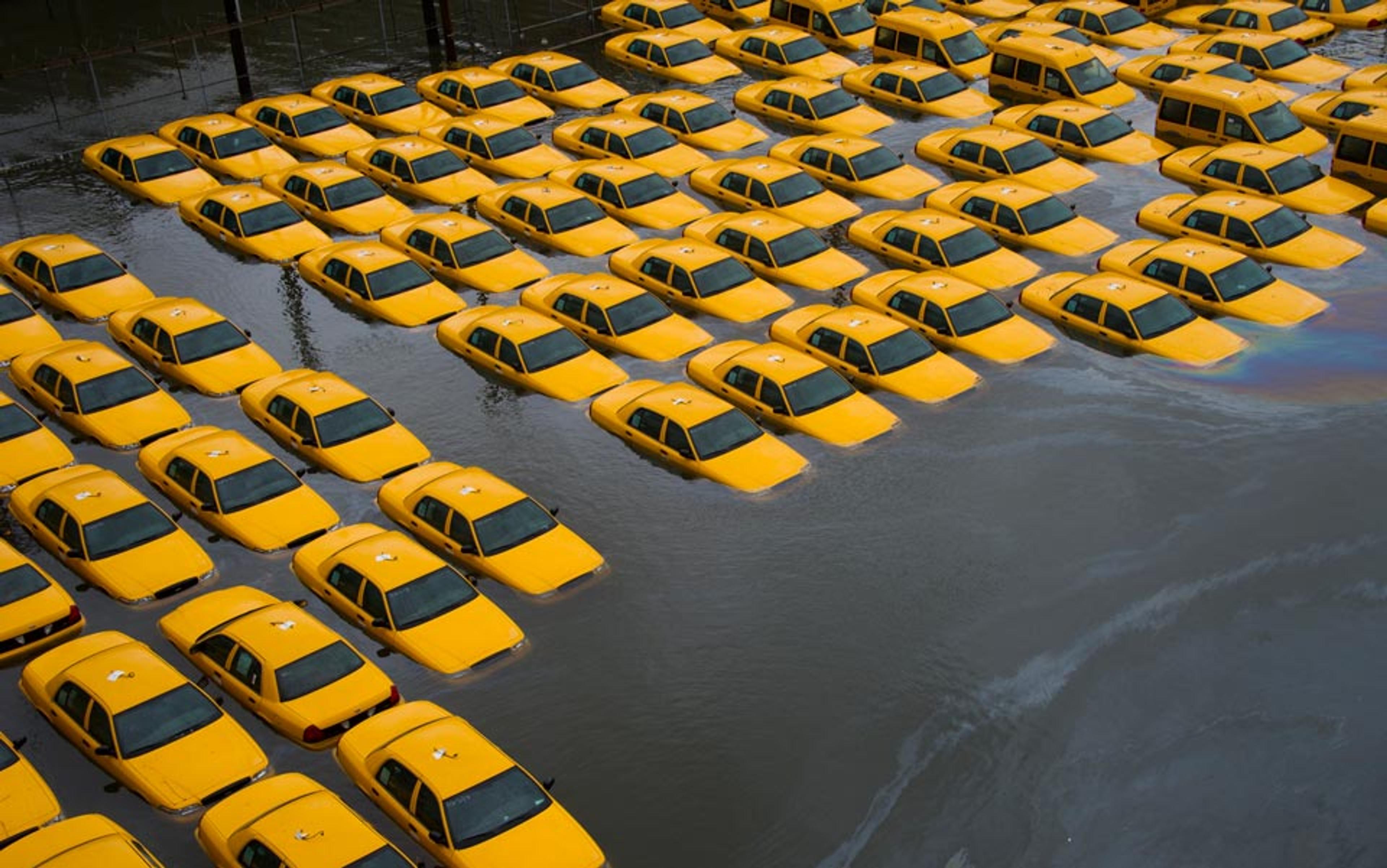When I recall the moments that I felt most OK – most calm, most present – I remember the times I was immersed in water. Sitting in a bath, swimming in a river, submerged in the ocean.
I think of the hot and cloudy summer’s day in 2021 when I drove from our home in New York City toward the coast with my husband, our young child and some friends. We are making the trek to Fort Tilden Beach in Queens, the coastal site of a former New York military installation with retired concrete gun emplacements beside a wedge of soft sand sinking into the Atlantic Ocean. After we arrive, we run with our child to the edge of the waves, pick up shells, pour white sand through our hands, lick our lips of the taste of saltwater and sunscreen. The waves are calm as I wade out. Passing through the small breakers, I lean back and float in the warm water – the stress of the city melts away. Sitting in the shade of our aqua blue beach tent, we share crunchy snacks and a big bottle of lime seltzer. We and dozens of others, peacefully encamped, have come for the water. We are deep under its spell.
I think of an evening at home in 2023. I have another baby now. We are in the bath at our Brooklyn apartment. I wash behind her ears, under her soft cheeks and in the creases of her thighs as she splashes and shouts with excitement. My older daughter takes a cup and pours water on her sister’s shoulders and down her back. We read Jill Murphy’s children’s book Five Minutes’ Peace (1986) about Mrs Large, an elephant mother who tries in vain to escape her children, seeking solace with a hot bath and a cup of tea. But when her children find her, they all climb in. And, though it’s a lot to manage, it’s also wonderful. I can relate to Mrs Large.
In my daily life in New York, as a working parent with two young kids, I find solace in water. And not just baths and beaches, but the many watery environments that urban planners and designers call ‘blue spaces’: rivers, pools, coastlines, ports and other waterways and watercourses. More than anything else, water calms me and brings me to the present. I love the way it sounds, the way it looks, and the way it smells. But, most importantly, I love the way it feels. And I’m not alone.
Many of us may instinctively sense that water can be a great healer. Science and history seem to confirm our intuitions: the therapeutic role of myriad blue spaces has been recognised for almost as long as people have immersed themselves in natural hot springs, pools, baths and oceans. Recent scientific research is continuing to explore the many healing qualities of water and, in the process, offering new therapeutic possibilities.
Today, millions of people around the world are impacted by anxiety, depression, psychosis and a range of other debilitating mental health challenges. In cities, these concerns are often sharp – and sharpest for those in low-income communities. But current treatments are insufficient, often failing to address the ways that environments shape mental health. Could collective hydrotherapy help?
Appearing in many culturally distinct shapes and sizes, communal city baths – including ancient Roman thermae, Turkish hammams and Japanese onsen – have long fostered a deep, healing sense of togetherness, abundance, relaxation and grounding. Many of these public spaces were successful because they were inexpensive (or free) and widely accessible. However, in New York and other unequal 21st-century cities, as more luxury baths and spas are built, public blue spaces are in decline. Pools are built over and poorly maintained; waterways are polluted and neglected; and ocean beaches are rendered inaccessible to those who most need their curative qualities.
Today, the benefits of blue spaces are unevenly distributed. Not everyone is able to experience the healing that comes from immersion. But what if we began thinking about the future of collective hydrotherapy differently in the context of our mental health crisis? What if we began to insist on our collective right to bathe?
Bathing has been celebrated as a therapeutic medium for millennia, but recent research has added to a library of historical anecdotal data to show that immersion in water of various temperatures improves blood flow, leads to pain reduction, and has psychological effects such as relaxation and reduced stress. People who regularly immerse in cold water for short periods of time have been found to be more active and alert, and have an overall improvement in mood. Other studies have found that water inspires awe, elicits a sensory response, soothes, stirs memories, and holds our attention. In Blue Mind (2014), the biologist Wallace J Nichols writes that just looking at the ocean creates a deeply relaxing state of ‘soft fascination’, which provides deep calm for our busy brains. ‘In the motion of water we see patterns that never exactly repeat themselves yet have a restful similarity to them.’ Our eyes, he writes, ‘are drawn to the combination of novelty and repetition.’
There is strong evidence suggesting that immersion in cold or hot water, or just being near a body of water, can be great for your nervous system and, therefore, your mental health. This has led researchers to consider the therapeutic benefits of water and blue spaces at the scale of a city. One interdisciplinary team of researchers in Scotland studied 132,788 people living in Glasgow over a 10-year period, from 2009 to 2018, to find out whether living near blue space changed the ways that socioeconomic deprivation impacted mental health. Unsurprisingly, proximity to blue space seemed to ease mental health risks, leading the researchers to suggest that it ‘could play an important role in reducing the burden of mental health inequalities in urban populations.’ In these situations, water is good for much more than just individual wellness. So why have cities, especially those riven with deep inequalities, not prioritised public access to safe, clean blue places?
To understand more about the collective benefits of water, I spoke with Lora Fleming, a co-founder of the European Centre for Environment and Human Health and chair of oceans, epidemiology and human health at the University of Exeter Medical School in the UK. Fleming started out in family medicine and then occupational medicine, serving low-income communities in the Bronx and then Miami, but has also spent much of her career studying the risks and hazards related to nature, specifically the ocean, such as harmful algal blooms, chemical pollution and dangerous microbes. Only relatively late in her career has she been able to shift her research to studying the health benefits of water.
Most cities in the world near waterways or coastlines treat water as something people need to be protected from
Research by Fleming and her colleagues has shown that it’s good to have access to clean waterfronts, especially for low-income coastal communities. This sometimes makes her feel like she’s studying the obvious. ‘Well, of course it’s good for you,’ people say when she shares her findings. ‘Why are you spending my tax dollars to prove this?’ The reason, she says, is unfortunate: we tend to ‘only value the things that we pay for.’ The benefits may seem obvious to some, but enduring cultural and institutional blind spots mean that the positive outcomes of blue spaces are not always valued nor protected, especially in big cities. We may know that bathing is therapeutic but blue spaces are often neglected as serious options when it comes to public health.
Most major cities in the world built near waterways or coastlines tend to treat water as an industrial and commercial resource, or something that people need to be protected from. Hong Kong faces Kowloon Bay, polluted and crowded with vessels; Lagos stretches beside its lagoons, and yet many of its beaches are privately owned; London expands around the turbid Thames; and across the US, most rivers near cities are too polluted to swim in (in Flint, Michigan, even clean drinking water has, infamously, not been a given). New York City is bordered by the Hudson and East rivers, but few people swim in those waterways today, due to concerns about bacteria (and strong currents). While European cities, such as Munich, have received attention for their successful efforts to purify rivers, these examples are few and far between.
By the early 20th century, industrialisation had ruined New York’s swimming waters. In a 1951 essay about the city’s harbour, Joseph Mitchell described the East River as oil-coated and waste-filled. Though New York’s waterways are cleaner now, thanks to programmes like the Billion Oyster Project, which is restoring water-purifying oyster reefs (and helping to prevent shoreline erosion and flooding), there is still a long way to go. The New York State Department of Health claims the water is cleaner today than it has been for more than a century, yet also recommends swimmers keep their heads above water (and mouths closed) at all times to avoid exposure to pollution, parasites, bacteria and algae.
Part of the problem is that the North American and European 19th-century model for city planning continues to shadow approaches to blue spaces. This model turns water into a technical problem. It is channelled into canals, sewers, aqueducts, pipes and drainage systems, which hides it from view and diminishes its longstanding cultural and physiological roles. There are good reasons why water continues to be framed as a problem worldwide. Waterways are often filled with chemical pollution, harmful algal blooms, pharmaceuticals and microplastics; around 2 million people die each year from water-borne diseases, such as cholera; and storms and floods are increasingly overwhelming urban infrastructure around the world. Many of these problems are likely to increase with the climate crisis. And then there is the simple existential problem that appears when humans enter the water: roughly 236,000 people drown each year, according to the World Health Organization. Yes, water is a collective risk in our cities. But it can also be a collective cure.
New York is a useful case study for thinking about the future of communal bathing in global cities. The city’s waterfronts have long been privatised and, today, bathing and blue spaces continue to generate private profits rather than public good. In the 2020s, there has been a boom in corporate-backed premium pools. In an article for the architecture magazine Curbed in 2023, Nicolas Kemper and A L Hu write that, during the past 50 years, the city of New York opened only five new public pools. But during the same period, developers built ‘at least 434’ private pools, and more than a quarter of those were built since 2016.
Many of New York’s public swimming pools were created as part of a Depression-era public works programme, and continued to be built until the local government halted construction during the 1970s financial crisis. A total of 53 free outdoor public pools were built, but these have not come close to fulfilling the possibilities of collective bathing. In the 2020s, New York’s public pools – sometimes the only swimming or bathing spaces easily accessible to low-income neighbourhoods – are not ideal. Many are not well maintained, have limited staffing, restricted hours, and visitors are subjected to arbitrary rules and heavy surveillance while they use the facilities.
As investment in public blue spaces has declined, there has been a concurrent boom in private ‘luxury’ spa facilities – a reflection of the growing influence of the ‘wellness’ industry on urban development. I must confess, a trip to one of these baths or spas is one of my favourite winter activities in the city, which I spread out because each visit is not cheap, ranging from around $50 to more than $100. These visits have become therapeutic rare treats, but also an indirect opportunity to create cultural connections with other bathers. After each visit, I leave feeling relaxed and closer to my local community. I also leave feeling irked that these experiences remain expensive due to a lack of investment in public goods. New York seems to have forgotten its past, its long history of communal bathing.
From the mid-1800s onwards, dozens of public baths were built in the city. Initially approved by middle-class reformers because they were seen as prosaically functional or ‘sanitary’, these spaces were later embraced by immigrant families as sites of cultural connection. Even in the early 1900s the baths charged nominal fees for use of ‘rain baths’ (showers) and ‘plunge’ or swimming pools. Although the last of these temples to industrial-era hygiene closed in the 1970s due to the advent of modern plumbing, I cannot help wondering what would have happened if they had been maintained and improved, like the public baths in Tokyo or Reykjavik, rather than deemed functionally obsolete through an overly narrow view of bathing based strictly on its sanitary value. Could they have become assets for the city’s mental health?
We jumped in cold plunges with pine tree wallpaper and even went into a snow room for a roll in some snow
Now, with little public investments in bathing, even modest shared bath options – including a Russian-style sauna in Brooklyn, or a Korean spa in Flushing, Queens – cost more than $40 per visit. And the newest spaces come with even heftier entrance fees, along with ice baths, whirlpools, marble-clad hammams, weight-loss treatments, lymphatic drainage massages, pilates instruction and more.
On an October morning, as the weather was cooling in the city, I paid $85 for weekday admission at one of these facilities. Inside, a friend and I visited different thematic rooms referencing hydrotherapy across the world: eastern European banyas, Moroccan and Turkish hammams, Japanese onsen baths. We jumped in cold plunges with pine tree wallpaper and even went into a snow room for a roll in some snow. Though the spaces in this spa referenced international cultures of bathing, we were clearly in New York. The other bathers were a diverse group of mostly young adults (no children allowed). The experience was framed as a kind of luxury staycation. But in a costly city where the minimum wage is around $15 per hour, regular access to such a facility is not possible for everyone. Across New York’s many communities, particularly those of cultural diasporas with connections to bathing, hydrotherapy is highly valued and entrance fees may be considered worth the price, yet I couldn’t help feeling that the approach of these kinds of facilities was insufficient. The promise of a truly collective, affordable form of hydrotherapy remains unfulfilled.
In the fall of 2022, while I was a postpartum mother, I spent some chilly afternoons at a small backyard spa in Brooklyn offering ‘community hydrotherapy’. For $45, I was able to spend two hours using a hot tub, sauna, steam room and cold plunge. While the sauna and steam room were often places for silence, I inevitably ended up chatting with other people in the tub. I spoke with a progressive rabbi, someone celebrating their birthday alone, other mothers of young children, teachers, psychologists, yoga instructors. Together, we traded stories and laughs during a rare moment of rest. Water can be a great equaliser. Everyone who comes to immerse themselves strips away more than their clothes as they submit to its healing powers; a good soak can melt egos and anxieties. This laid-back spa offered a safe and special experience but, again, I felt this was just the beginning of what is possible. Relatively simple and affordable community hydrotherapy for each neighbourhood should be a right, not a privilege. These simple spaces could easily be reimagined as fundamental parts of local urban infrastructure.
And then there are the beaches. The issues here are related more to access: many of New York’s best beaches have minimal options for public transport. Coney Island beach is accessible by subway, and Orchard Beach by bus, but others, like Jacob Riis or Fort Tilden (mentioned at the beginning), are difficult to reach without a car, taxi or bike. Even then, the parking rules are restrictive. But for those who have the time to make the pilgrimage across the city, these relatively inaccessible beaches can be great sanctuaries.
So, what might the future of collective hydrotherapy look like in a city such as New York? Already, more inclusive visions for urban bathing and collective care are taking shape. The New York-based design and architecture firm Only If has recently developed a proposal to turn one of the city’s public pools into a year-round facility called the People’s Pool. The proposal was exhibited at the Museum of Modern Art in 2023, and the architect Karolina Czeczek and the photographer Anna Morgowicz produced an accompanying catalogue of New York’s public pools to highlight ‘issues related to urban waters’. As a response to growing concerns about these issues, the Lasker public pool in north Central Park is currently being renovated.
Other designers and planners are also pushing for approaches to communal bathing that go beyond real estate investments or luxury facilities. A project called +Pool, planned for 2024, will install a plus sign-shaped public pool in the East River. This large floating facility would filter river water through its submerged walls. The team behind the project aim to start with one pool and scale up with numerous facilities around the city. Their mission is to provide equitable access to the city’s waterways, and free swimming lessons to all.
What these bathing projects offer is a form of targeted universalism, a means of reaching universal goals for a general population by supporting the needs of particular groups in different ways. Targeted universalism is an approach to public health and policy inequities that goes beyond universal policies (which treat everyone equally) to focus on targeted policies that centre the needs of some people in ways that end up being good for everyone. Targeted universalism could be used as a framework to create access to blue spaces for all, while centring the needs of those who have historically been denied access to collective watery spaces.
Of course, bathing isn’t a panacea. Urban leadership in cities like New York should not avoid reckoning with the complexities faced by low-income communities, particularly those affected by the racial wealth gap. Policy-makers need to focus on addressing economic inequities and systemic racism, while also providing affordable therapy and other traditional forms of mental health support. In New York, intersecting affordable housing, healthcare and cost-of-living crises have become dire. On the horizon, heat-related issues exacerbated by the climate crisis are also expected to worsen for city residents, especially for communities of colour. Access to blue spaces would not solve these crises, but might provide meaningful collective support for those in the city who feel the mental health impacts of these issues most sharply. The city is notorious for being a stressful place, with many experiencing long work hours and difficult commutes. Today, even middle-class New Yorkers struggle to stay in the city due to rising rents and the cost of childcare or eldercare, while the most vulnerable may not be able to afford food at skyrocketing prices, let alone enjoy the rest and relaxation of a communal bath or pool.
The clinical psychologist Michael McRae has designed programmes and interventions to support mental health and wellbeing on behalf of New York City’s Department of Health and Mental Hygiene. When I interviewed him for Urban Omnibus in 2023, he reminded me that finding ways of going beyond traditional psychiatric programmes is essential in a city like New York. ‘It’s not just about clinical services,’ he said. ‘What about massage, acupuncture … and other holistic forms of care that contribute to one’s healing? I think people who are experiencing homelessness, mental health challenges, substance use issues, coming home from jail or prison, they deserve to be pampered even more and shown love and support by us all, including government, you know? That’s equity, right? It’s really giving them the boost they need to feel good about themselves or to live happy, productive lives, and to ultimately thrive .’
Water can be a key element for providing holistic forms of equitable care. It can play a central role in addressing gaps in equity when it comes to our collective mental health and wellbeing.
There is a lack of cultural imagination about the potential for water to help us to thrive
Models for collective bathing do in fact exist, they’re just not easily accessible in New York. In Europe and the UK, there are trends toward public cold water plunges and reclaiming parts of urban waterways for mental health swims. But such initiatives tend to emerge in national systems that use public funds to prioritise collective wellbeing.
Many cities currently do not consider bathing at the scale of the population, nor do they prioritise equitable access to bathing. Water can do so much more. Investing in low-income coastal communities is an efficient use of money when thinking about health at the scale of a city, as Fleming and others argue. Creating accessible bathing infrastructure for coastal cities is a way of setting universal goals that can help everyone in different ways – targeted universalism. Hydrotherapy and cold-water immersion help with chronic pain and mental health; water immersion helps people of any age and ability, and can be a joyous, collective public experience. Also, historically, it’s an experience that can be affordable (or free) and made widely accessible. It should be a right. Instead, it has been privatised and rendered largely inaccessible.
Despite the clear health benefits, public narratives about urban waterways are dominated by a need to manage risks, threats and litigation: flooding, combined sewer overflows, rip tides, not enough lifeguards. While these threats from blue spaces are real, there is a lack of cultural imagination about the potential for water to help us to thrive.
Many visions for the future of collective hydrotherapy still remain dreams. What would a different future look like? How do we reclaim the right to bathe?
In New York, for me, it would look like free shuttle bus services to every public beach; doubling the number of free outdoor public pools and free year-round indoor public pools; retrofitting existing recreation centres and pools, and significantly increasing their maintenance budgets. It could mean investing tax dollars and providing subsidies or, at a minimum, tax write-offs to small businesses to build backyard neighbourhood health centres that offer access to small pools, hot tubs and steam rooms that are equitably distributed throughout the city, centring both social and environmental sustainability. While these would ideally be free, low-cost access could also be provided on a sliding scale, or through affordable healthcare plans or even specific opening hours for the local community. Given the magnitude of its benefits, a reimagining of public bathing infrastructure would be a relatively easy intervention.
Opportunities to immerse in water can improve the mental health of millions. The world’s urban leadership should radically rethink bathing as it relates to wellbeing and ask how equitable access to collective blue spaces could be integrated more deeply into urban infrastructures and public health plans in global cities. We are living in times of crisis that require a global reconceptualisation of public health and urban planning. And some of our best solutions to the biggest health challenges may be the simplest ones. Water could do so much more for us. It is time to insist on our collective right to bathe.






